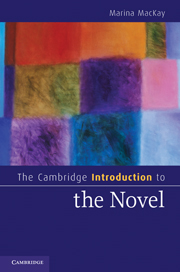Book contents
- Frontmatter
- Contents
- Acknowledgments
- About this book
- Chapter 1 Why the novel matters
- Miguel de Cervantes, Don Quixote (1605, 1615)
- Chapter 2 Origins of the novel
- Laurence Sterne, The Life and Opinions of Tristram Shandy, Gentleman (1759–67)
- Chapter 3 Narrating the novel
- James Hogg, The Private Memoirs and Confessions of a Justified Sinner (1824)
- Chapter 4 Character and the novel
- Nathaniel Hawthorne, The Scarlet Letter (1850)
- Chapter 5 Plotting the novel
- Gustave Flaubert, Madame Bovary (1857)
- Chapter 6 Setting the novel
- Charles Dickens, Bleak House (1853)
- Chapter 7 Time and history
- Virginia Woolf, To the Lighthouse (1927)
- Chapter 8 Genre and subgenre
- Graham Greene, The Ministry of Fear (1943)
- Chapter 9 Novel and anti-novel
- Thomas Pynchon, The Crying of Lot 49 (1966)
- Chapter 10 Novel, nation, community
- Salman Rushdie, Midnight's Children (1981)
- Chapter 11 Concluding
- Notes
- Glossary
- Further reading
- Index
- Cambridge Cultural Social Studies
Chapter 4 - Character and the novel
Published online by Cambridge University Press: 05 June 2012
- Frontmatter
- Contents
- Acknowledgments
- About this book
- Chapter 1 Why the novel matters
- Miguel de Cervantes, Don Quixote (1605, 1615)
- Chapter 2 Origins of the novel
- Laurence Sterne, The Life and Opinions of Tristram Shandy, Gentleman (1759–67)
- Chapter 3 Narrating the novel
- James Hogg, The Private Memoirs and Confessions of a Justified Sinner (1824)
- Chapter 4 Character and the novel
- Nathaniel Hawthorne, The Scarlet Letter (1850)
- Chapter 5 Plotting the novel
- Gustave Flaubert, Madame Bovary (1857)
- Chapter 6 Setting the novel
- Charles Dickens, Bleak House (1853)
- Chapter 7 Time and history
- Virginia Woolf, To the Lighthouse (1927)
- Chapter 8 Genre and subgenre
- Graham Greene, The Ministry of Fear (1943)
- Chapter 9 Novel and anti-novel
- Thomas Pynchon, The Crying of Lot 49 (1966)
- Chapter 10 Novel, nation, community
- Salman Rushdie, Midnight's Children (1981)
- Chapter 11 Concluding
- Notes
- Glossary
- Further reading
- Index
- Cambridge Cultural Social Studies
Summary
And there, for the time being, let us leave Vic Wilcox, while we travel back an hour or two in time, a few miles in space, to meet a very different character. A character who, rather awkwardly for me, doesn't herself believe in the concept of character. That is to say (a favourite phrase of her own), Robyn Penrose, Temporary Lecturer in English Literature at the University of Rummidge, holds that “character” is a bourgeois myth, an illusion created to reinforce the ideology of capitalism.
David Lodge, Nice Work (1988)This passage from David Lodge's Nice Work raises the two main issues that this chapter explores: our readiness to imbue with both individuality and reality entities that we know do not exist (we “meet” Robyn as we would a living person), and twentieth-century criticism's erosion of our investments in novelistic character, as something to be questioned rather than taken for granted (Robyn “doesn't believe in the concept of character”). Clearly having read her Ian Watt (see Chapter 2), Robyn believes that character represents an “illusion” of a self-motivating individual invented in the eighteenth century to serve the interests of an emergent capitalist society; by this she means that the novel is both a product and a conduit of capitalist ideology because it imagines human beings only as competitive, acquisitive individuals and then makes this view of selfhood seem naturally and self-evidently true. It is less clear that Robyn's author agrees.
- Type
- Chapter
- Information
- The Cambridge Introduction to the Novel , pp. 64 - 78Publisher: Cambridge University PressPrint publication year: 2010

